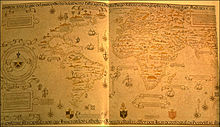For other uses, see New World (disambiguation).

The World Map by Diogo Ribeiro (1529) labels the Americas as MUNDUS NOVUS. It traces most of South America and the east coast of North America.
Contents |
Name origin
Vespucci probably came to this realization in June of 1502, during a famous chance meeting between two different expeditions at the watering stop of "Bezeguiche" (the Bay of Dakar, Senegal) - his own outgoing expedition, on its way to chart the coast of newly-discovered Brazil, and the vanguard ships of the Second Portuguese India armada of Pedro Alvares Cabral, returning home from India. Having already visited the Americas in prior years, Vespucci probably found it difficult to reconcile what he had already seen in the West Indies, with what the returning sailors told him of the East Indies. Vespucci wrote a preliminary letter to Lorenzo, while anchored at Bezeguiche, which he sent back with the Portuguese fleet - at this point only expressing a certain puzzlement about his conversations.[2] Vespucci was finally persuaded when he proceeded on his mapping expedition through 1501-02, covering the huge stretch of coast of eastern Brazil. After returning from Brazil, in the Spring of 1503, Amerigo Vespucci composed the Mundus Novus letter in Lisbon to Lorenzo in Florence, with its famous opening paragraph:[3]
Vespucci's letter was a European publishing sensation, immediately (and repeatedly) reprinted in several other countries.[4]In passed days I wrote very fully to you of my return from new countries, which have been found and explored with the ships, at the cost and by the command of this Most Serene King of Portugal; and it is lawful to call it a new world, because none of these countries were known to our ancestors and all who hear about them they will be entirely new. For the opinion of the ancients was, that the greater part of the world beyond the equinoctial line to the south was not land, but only sea, which they have called the Atlantic; and even if they have affirmed that any continent is there, they have given many reasons for denying it is inhabited. But this opinion is false, and entirely opposed to the truth. My last voyage has proved it, for I have found a continent in that southern part; full of animals and more populous than our Europe, or Asia, or Africa, and even more temperate and pleasant than any other region known to us.
The Spanish scholar Peter Martyr d'Anghiera used the term "New World"[5] with some twenty editions over the next four years.
In 1524, the term was also used by Giovanni da Verrazzano in a record of his voyage that year along the Atlantic coast of land that is now part of the United States and Canada.[6]




Tidak ada komentar:
Posting Komentar